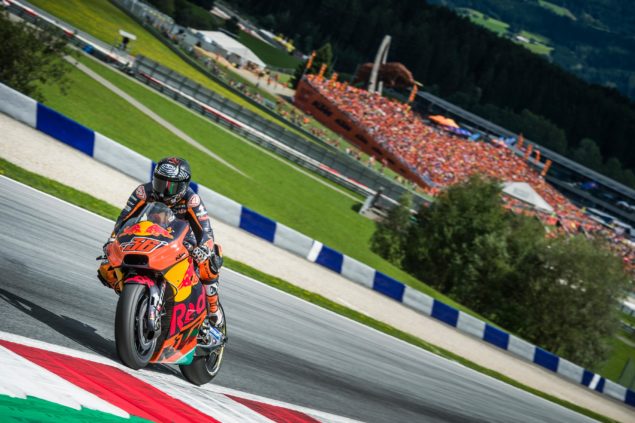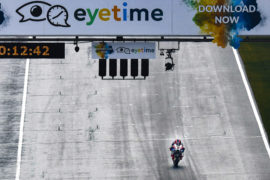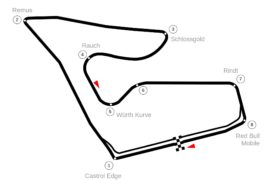All the old certainties about MotoGP are gone. A few short years ago, MotoGP had a consistent, simple internal logic that made it easy to explain. All that is now gone.
The things we believed were universal truths about racing have turned out to be mere mirages, disguising an ever-shifting reality. And that has made racing mind-bogglingly good.
A case in point. The Red Bull Ring at Spielberg in Austria has a pretty simple layout. Straight, corner, straight, corner, straight, corner, long loop which comes back on itself, straight, corner, short straight, corner, and we’re back at the beginning.
The track is all about horsepower and the ability to accelerate hard, then brake hard. The racing here should be rubbish. The rider with the fastest bike should be able to escape and cruise to victory by tens rather than tenths of seconds.
Yet on Sunday, we saw three gripping races, where the results were long in doubt. The winner of the Moto3 race may have been well clear, but the freight train behind it scrapping over second made for compulsive watching.
Moto2 cooked up another cracker – the fourth in a row, a sign the class is changing – which only really settled in the last four laps. And the MotoGP race became an instant classic, one which make any collection of top ten races of any era.
It truly had everything: a large group battling for the lead, then a smaller group slugging it out, three abreast heading towards a corner. There were hard passes, missed passes, and a wild last-corner lunge to attempt to snatch victory.
Not Supposed to Happen
It wasn’t just the race track that deceived. The things we thought we knew about bikes turned out to be false as well.
Ducatis are supposed to have great drive out of corners, making them unbeatable down the straights, yet the two Repsol Hondas consistently gained ground on the factory Ducatis in acceleration, flying past them on the straights.
The Hondas are supposed to make up for their weak acceleration by being demons on the brakes, yet time after time, the Andrea Dovizioso and Jorge Lorenzo stuffed the Hondas into the corners, outbraking them with ease.
The Ducatis are supposed to be rocketships, untouchable in terms of top speed, yet Jorge Lorenzo was second-slowest overall, down by 6 or 7 km/h on the rest of the field.
Then again, the fact that the old certainties have gone is surely a good thing. The racing has become unpredictable again, and though we did not get a sixth winner of the season at the Red Bull Ring, we did get a surprise one.
All eyes were on Marc Márquez, as the Repsol Honda rider had dominated practice and laid down a searing pace in all of his race preparation. Instead, it was Andrea Dovizioso who had half snuck under the radar, beating Márquez at his own game.
There were two Hondas on the podium, of what was supposed to be a Ducati track, and the Yamahas, the only bikes capable of following the Ducatis last year, were nowhere to be seen.
How did Andrea Dovizioso win this race? Experience and guile, a deadly combination. Ducati teammate Jorge Lorenzo streaked into the lead from the start then took off like a scalded cat, opening up a gap in the first few laps.
“I just had a better feeling than the rest with cold tires, with new tires, and I could take this advantage,” Lorenzo explained after the race. But Lorenzo’s lead would only last until shortly before the halfway mark.
Márquez had closed the one-second gap Lorenzo had opened by lap 5, and 6 laps later Lorenzo would be swallowed up by both Márquez and his teammate Dovizioso.
Saving for Later
Lorenzo had a pretty clear idea of what had happened to him. He had had two main problems to deal with. “We were very close with the fuel,” Lorenzo said.
“So from lap 3, I needed to put the last switch of the fuel setting, the lowest power one, and my bike was slower than normal. I lost so much on the straights compared to the three guys. And then from lap 12, 15 I started losing a lot of traction on the right side, and I needed to slow down.”
Neither Dovizioso nor Márquez had had that problem, they told the press conference. “Fortunately my speed was very good and at the beginning I didn’t push,” Dovizioso said. “I saved the tire and when you save the tire you save also the fuel.”
Márquez had been forced to save fuel. “In the beginning the pace was slow,” the Spaniard said. “He was saving the tire. I was saving fuel.”
Saving the tire was something that Dovizioso had learned from last year. In 2016, he had been beaten here by his teammate after Andrea Iannone had held back for most of the race conserving his soft tire.
In 2017, Dovizioso had also gone for the soft tire, instead of the medium he had chosen last year. It was also a skill which had stood him in good stead in Barcelona, when he won his second race of 2017.
Putting that all together put him in a position to enter the final lap in the lead, with only a hard charging Márquez to fend off.
The Hardest Pass
That is easier said than done. It helped that Dovizioso knew the attack was coming. “Yeah, it happens every time,” Dovizioso said. “In the last lap, Marc always try to do something.”
That something proved to be absolutely spectacular. Though he crossed the line to start the first lap right on the tail of Dovizioso, Márquez was nearly four tenths behind by the halfway mark.
The Italian knew that his only chance of victory was to put as much clear air between himself and Lorenzo before the two long lefts at Turns 6 and 7. “In the last lap it was very difficult for me because I lose a lot in the two left corners. It was easy for him to overtake me.”
Dovizioso tried to hold his line through the double left, keeping the door firmly shut. As the Italian had feared, Márquez was coming. The Repsol Honda rider gobbled up the ground between himself and the Ducati: in just a single sector, he had grabbed back three tenths of a second.
Dovizioso knew that Márquez was coming, and tried to thwart what he thought would be the Spaniard’s last chance by braking outrageously late into Turn 9.
That defensive moved worked perfectly, but this was not the day Marc Márquez was going to roll over and accept defeat. “I try to pass on the last corner because if I don’t, I cannot go to sleep. I need to try,” Márquez said.
He attempted a move that was wild, risky, and absolutely at the limit of traction. “I didn’t expect the last corner he would try to overtake me because there is no space there, there is no braking area,” Dovizioso explained. But that would not stop Márquez.
Dovizioso’s braking maneuver had left him out wide on the exit of Turn 9, with the door open on the inside of Turn 10 if Márquez was close enough. The Repsol Honda rider saw the gap, and took a last desperate lunge, diving inside Turn 10 with his bike barely under control.
“In the end, I arrive in the limit,” Márquez said of the attempt. It was no exaggeration: the front end squirmed, the rear end fishtailed and slid, Márquez riding on the ragged edge of control.
If you want to see what 100% looks like, I suggest you go and watch the replay a few times. Márquez had the rear wheel stepping out motocross style just to try to make the corner, searching for all available grip.
Having a Plan Is Half the Battle
But Dovi was ready. “I leave the door open because if I close the door for sure he hit me and he is able to win,” he said. “I leave the door open to try to exit faster, but he was good to stop the bike and try to exit really fast, but I was faster than him in the exit.”
Knowing that Márquez was coming, Dovizioso let the wild man Márquez pass underneath, then focused on getting drive on exit and outdragging the Honda to the line.
The plan worked perfectly, though the adrenaline Márquez’s pass had generated left Dovizioso fired up and angry. “I have a strange feeling in the last corner,” he said. “I was more angry than happy because he try to overtake me in that way. That is not a corner to try to overtake a rider.”
Dovizioso steamed out of the corner for the win with a wild wave of his arm, a signal all too clearly made. His anger did not last long, though, quickly replaced by the joy of victory.
That last lap was one for the ages. Not just because of the excitement it engendered, but also because of the extraordinary skill on display. Márquez’s pass was attempted at the absolute limit of traction. A little over it, in fact, the rear sliding out from under him before he could get it back under control.
But Dovizioso’s response was no less impressive: he had anticipated the attack, conceived of countermeasures, then not lost his cool when it came time to execute them. It was the most level-headed, carefully thought out, and brilliant defense imaginable.
Cool Heads
In his third win of the season, Dovizioso showed just how far he has come as a rider. It was a race he won with both his brain and with his bravery. His mental fortitude, too, remaining unflustered despite an onslaught from the most determined man in the paddock.
Once again Dovizioso refused to talk about the changes in his life, saying only that it had been down to small changes he had made. Those changes are more to the way he thinks about things, helping his concentration. Dovizioso is the most cerebral of riders, and this is now becoming a major strength.
A win for Dovizioso and second for Márquez have punched what is starting to look like a decisive hole in the championship. Márquez has only extended his lead by 2 points, to a total of 16. But that lead is now over Dovizioso, rather than Maverick Viñales, the two factory Yamahas finishing in sixth and seventh.
Viñales trails Márquez by 24 points, now, while Valentino Rossi has fallen back to 33 points behind Márquez. Rossi’s shot at a title is starting to look out of reach, despite there still being seven races left.
Trailing by more than a race win at this stage of the season is a pretty big hill to climb. Viñales is still in the safe zone, though there is not much in it. Yamaha cannot afford to have another weekend like this if Viñales or Rossi are to remain title contenders.
How to Lose a Championship
What went wrong for the factory Yamahas? Plenty. First of all, they finished with too many bikes between themselves and the championship leader Márquez.
Secondly, they finished with the satellite Monster Tech 3 Yamaha of Johann Zarco ahead of them, and out of reach. The biggest problem both Rossi and Viñales had was a rear tire which dropped too quickly.
“After twelve laps I had a big drop from the rear tire and I have to slow down a lot,” Rossi said. “The bike become very difficult to ride and I did also one mistake in braking.”
This has been a recurrent problem in recent races. For some reason, the 2017 Yamaha M1 is incapable of making a rear tire last. Which is odd, as that is precisely the objective the bike had been designed to achieve. When the bike has grip, it is fast, but it runs out quickly after wearing down the tires.
Where are these issues coming from? A bit of everything, it seems. Mainly, though, the other bikes are better than the Yamaha, with the Honda especially having made a massive step forward.
“I think we improve because today in the first ten laps I have a good pace, but the degradation of the rear tire remain the problem,” Rossi explained. “I think mechanically the other bikes use less the rear tire and also they find some better solution for the electronics to make good acceleration without spin.”
Is reverting to the 2016 chassis an option? Johann Zarco finished ahead of both Rossi and Viñales in Austria. On the other hand, Zarco only finished a couple of seconds ahead of Valentino Rossi, but he also finished seven seconds behind the winner.
The aim of the Movistar Yamaha team is not to beat the satellite team, of course, but to win them MotoGP races and championship.
Getting There
Sandwiched between Zarco and the podium was Jorge Lorenzo. If anything, Lorenzo was frustrated with himself after the race. “We must be satisfied, but not happy,” Lorenzo put it succinctly.
“It’s not the best result, because in Jerez I finished third. But in Jerez I finished 14 seconds from Dani, in Montmelo I finished 9 seconds from Dovi, but this time is the lowest difference. Also I lead more laps than ever, ten laps. Again I was in the first row.”
Where does this leave Lorenzo in his quest for glory on the Ducati Desmosedici GP17? The Spaniard believes he is close to being competitive. “Every time I am more natural on the bike, I’m getting more experience, more knowledge, and sooner or later we will make it happen,” Lorenzo said.
When will we see this final breakthrough? “It can happen any time … it depends on the track, there are some tracks that are better for you or for your riding. I don’t consider Austria the best one for me. But it could happen in Silverstone, could happen in Misano. The important thing is that we reduced a lot the gap with the fastest riders.”
Is this another false dawn? Lorenzo has had a couple since his switch to Ducati. Yet this one feels more real than the others which have come and gone.
Lorenzo has been putting together the pieces of the jigsaw puzzle, and just a few holes remain. He will need help from Ducati Corse boss Gig Dall’Igna. But it is up to him to actually make the breakthrough.
Johann Zarco finished in fifth, ahead of the Movistar Yamaha riders once again. His secret weapon was his smoothness, which allowed him to run the soft rear tire and make it last for the race.
With each new race, Zarco is establishing himself among the serious title contenders, and staking a claim for a full factory onslaught in the near future.
Extra Benefit
Beyond the leaders, there were extraordinary achievements up and down the field. Loris Baz, who looks like he is set to lose his ride at Avintia Ducati, rode a superb race to finish ninth, just behind an equally impressive Alvaro Bautista.
Baz remains one of the more underrated riders in the paddock, his height all too often held against him.
Special mention must go to Mika Kallio on the KTM. The Finnish test rider for the Austrian factory crossed the line in tenth, in a completely dry race. The bike is making fast leaps and bounds forwards as the focus switches from just throwing new parts at the problem to actually refining what they have.
Kallio finished less than 20 seconds off the pace, their closest result so far this season. There is still a lot of work to do, but the home stretch is finally starting to appear.
Photo: KTM
This article was originally published on MotoMatters, and is republished here on Asphalt & Rubber with permission by the author.




